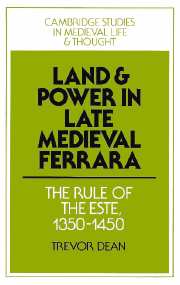Book contents
- Frontmatter
- Contents
- List of maps
- Preface
- List of abbreviations
- Note on sources
- Note on money, measurements and terms
- 1 Introduction
- 2 The Este patrimony
- 3 The Este vassals and their fiefs
- 4 Feudal tenure at Ferrara
- 5 Noble society at the centre
- 6 Noble society in the provinces
- Conclusion
- Appendices
- Bibliography
- Index
3 - The Este vassals and their fiefs
Published online by Cambridge University Press: 10 November 2009
- Frontmatter
- Contents
- List of maps
- Preface
- List of abbreviations
- Note on sources
- Note on money, measurements and terms
- 1 Introduction
- 2 The Este patrimony
- 3 The Este vassals and their fiefs
- 4 Feudal tenure at Ferrara
- 5 Noble society at the centre
- 6 Noble society in the provinces
- Conclusion
- Appendices
- Bibliography
- Index
Summary
The Estensi had vassals in Ferrara long before the establishment of their signoria in 1264, but it is only from the last decades of the thirteenth century that large numbers of Este feudal grants survive. These are collected in a variety of sources: the ‘statements of vassalage’ collected from vassals in 1272–3 and 1285–6, individual charters, the registers of cameral notaries from the mid-fourteenth century and the continuous series of Catastri delle Investiture from 1393. These provide two means of analysis of Este vassals: the thirteenth-century statements and the first of the Catastri offer frozen pictures of the vassals and their fiefs at particular moments, while the charters, registers and remaining Catastri provide a continuous chronological picture, complete from 1393. Combined, all these sources enable us to answer a wide range of questions about late medieval feudalism: who the feudatories were, how much land they held, the precise content of the feudal relationship and its connection with the social and political reality of lordship.
NUMBER OF VASSALS; SIZE OF FIEFS
The first Catastro contains almost exclusively renewals of fiefs made in 1394–5 in accordance with a proclamation issued in April 1394 ordering all vassals to present their charters for confirmation and reinvestiture. The total number of reinvestitures made in these two years was 353, but some of these must be deleted (duplications, investitures to heirs), while others must be added.
- Type
- Chapter
- Information
- Land and Power in Late Medieval FerraraThe Rule of the Este, 1350-1450, pp. 74 - 108Publisher: Cambridge University PressPrint publication year: 1987



